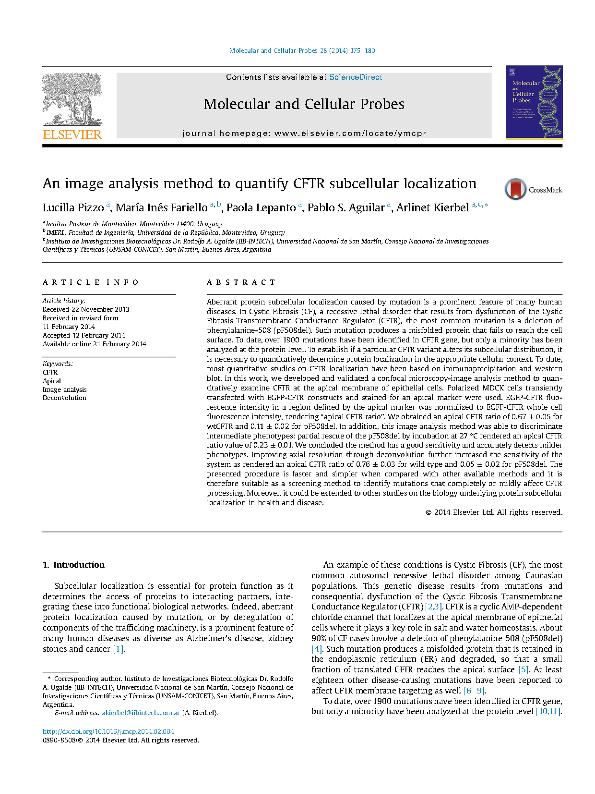Artículo
An image analysis method to quantify CFTR subcellular localization
Pizzo, Lucilla; Fariello, María Inés; Lepanto, Paola; Aguilar, Pablo Sebastián ; Kierbel, Arlinet Verónica
; Kierbel, Arlinet Verónica
 ; Kierbel, Arlinet Verónica
; Kierbel, Arlinet Verónica
Fecha de publicación:
02/2014
Editorial:
Academic Press Ltd-elsevier Science Ltd
Revista:
Molecular And Cellular Probes
ISSN:
0890-8508
Idioma:
Inglés
Tipo de recurso:
Artículo publicado
Clasificación temática:
Resumen
Aberrant protein subcellular localization caused by mutation is a prominent feature of many human diseases. In Cystic Fibrosis (CF), a recessive lethal disorder that results from dysfunction of the Cystic Fibrosis Transmembrane Conductance Regulator (CFTR), the most common mutation is a deletion of phenylalanine-508 (pF508del). Such mutation produces a misfolded protein that fails to reach the cell surface. To date, over 1900 mutations have been identified in CFTR gene, but only a minority has been analyzed at the protein level. To establish if a particular CFTR variant alters its subcellular distribution, it is necessary to quantitatively determine protein localization in the appropriate cellular context. To date, most quantitative studies on CFTR localization have been based on immunoprecipitation and western blot. In this work, we developed and validated a confocal microscopy-image analysis method to quantitatively examine CFTR at the apical membrane of epithelial cells. Polarized MDCK cells transiently transfected with EGFP-CFTR constructs and stained for an apical marker were used. EGFP-CFTR fluorescence intensity in a region defined by the apical marker was normalized to EGFP-CFTR whole cell fluorescence intensity, rendering “apical CFTR ratio”. We obtained an apical CFTR ratio of 0.67 ± 0.05 for wtCFTR and 0.11 ± 0.02 for pF508del. In addition, this image analysis method was able to discriminate intermediate phenotypes: partial rescue of the pF508del by incubation at 27 °C rendered an apical CFTR ratio value of 0.23 ± 0.01. We concluded the method has a good sensitivity and accurately detects milder phenotypes. Improving axial resolution through deconvolution further increased the sensitivity of the system as rendered an apical CFTR ratio of 0.76 ± 0.03 for wild type and 0.05 ± 0.02 for pF508del. The presented procedure is faster and simpler when compared with other available methods and it is therefore suitable as a screening method to identify mutations that completely or mildly affect CFTR processing. Moreover, it could be extended to other studies on the biology underlying protein subcellular localization in health and disease.
Palabras clave:
Cftr
,
Apical
,
Image Analysis
,
Deconvolution
Archivos asociados
Licencia
Identificadores
Colecciones
Articulos(IIB-INTECH)
Articulos de INST.DE INVEST.BIOTECNOLOGICAS - INSTITUTO TECNOLOGICO CHASCOMUS
Articulos de INST.DE INVEST.BIOTECNOLOGICAS - INSTITUTO TECNOLOGICO CHASCOMUS
Citación
Kierbel, Arlinet Verónica; Aguilar, Pablo Sebastián; Lepanto, Paola; Fariello, María Inés; Pizzo, Lucilla; An image analysis method to quantify CFTR subcellular localization; Academic Press Ltd-elsevier Science Ltd; Molecular And Cellular Probes; 28; 2-2014; 175-180
Compartir
Altmétricas



